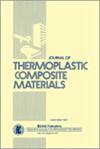Radiation preparation and antimicrobial activity of Poly(PVA/starch/Ag NPs) nanocomposite towards Penicillium digitatum on citrus fruits
IF 3.4
4区 材料科学
Q2 MATERIALS SCIENCE, COMPOSITES
引用次数: 0
Abstract
The synthesis of Poly(PVA/St/Ag NPs) nanocomposite by using of gamma radiation was carried out. The progress of the reaction was examined by using different techniques such as Fourier transform infrared (FTIR), transmission electron microscopy (TEM), UV, XRD, and scanning electron microscopy (SEM). The FTIR show the successful preparation of the Poly(PVA/St/Ag NPs) nanocomposite by gamma radiation at a dose of 5 kGy. The TEM analysis displays the particle size distribution of Ag NPs and it is observed that the Ag NPs size was in the range of 21-30 nm. The SEM images show a good distribution of silver nanoparticles in the Poly(PVA/St/Ag NPs) nanocomposite. matrix, but with little agglomerations or aggregates observed on the surface of the Poly(PVA/St/Ag NPs) nanocomposite. The XRD analysis indicates that amorphous regions are enhanced in the Poly(PVA/St/Ag NPs) nanocomposite. The coating of Citrus fruits by of Poly(PVA/St/Ag NPs) nanocomposite showed better performance in inhibition of the growth of P. digitatum on citrus fruits than free Ag NPs at concentration of 30 ppm. The incorporation of Ag NPs in Poly(PVA/St/Ag NPs) nanocomposite has extremely obvious antifungal activities against P. digitatum due to the nanometer range of Ag NPs that can interact with P. digitatum surface and/or its core where it enters inside the cell, as a result, cellular metabolism is inhibited causing death of P. digitatum and subsequently exhibits antifungal activities.聚乙烯醇/淀粉/银纳米复合材料对柑桔指状青霉菌的辐射制备及抑菌活性研究
利用伽马射线合成了聚(PVA/St/Ag)纳米复合材料。采用傅里叶变换红外(FTIR)、透射电子显微镜(TEM)、紫外(UV)、x射线衍射(XRD)和扫描电子显微镜(SEM)等技术对反应进行了表征。FTIR结果表明,在5 kGy的伽马辐射下,Poly(PVA/St/Ag NPs)纳米复合材料成功制备。TEM分析显示了Ag NPs的粒径分布,Ag NPs的粒径范围在21 ~ 30 nm之间。SEM图像显示,银纳米粒子在Poly(PVA/St/Ag NPs)纳米复合材料中分布良好。而聚(PVA/St/Ag NPs)纳米复合材料表面几乎没有团聚或聚集现象。XRD分析表明,Poly(PVA/St/Ag NPs)纳米复合材料中非晶态区增强。聚(PVA/St/Ag NPs)纳米复合材料包被柑橘果实对指状线虫生长的抑制效果优于浓度为30 ppm的游离Ag NPs。在Poly(PVA/St/Ag NPs)纳米复合材料中加入Ag NPs,由于Ag NPs可以在纳米范围内与指状假丝藤表面和/或其核心相互作用,从而进入细胞内部,从而抑制细胞代谢,导致指状假丝藤死亡并表现出抗真菌活性,因此对指状假丝藤具有非常明显的抗真菌活性。
本文章由计算机程序翻译,如有差异,请以英文原文为准。
求助全文
约1分钟内获得全文
求助全文
来源期刊

Journal of Thermoplastic Composite Materials
工程技术-材料科学:复合
CiteScore
8.00
自引率
18.20%
发文量
104
审稿时长
5.9 months
期刊介绍:
The Journal of Thermoplastic Composite Materials is a fully peer-reviewed international journal that publishes original research and review articles on polymers, nanocomposites, and particulate-, discontinuous-, and continuous-fiber-reinforced materials in the areas of processing, materials science, mechanics, durability, design, non destructive evaluation and manufacturing science. This journal is a member of the Committee on Publication Ethics (COPE).
 求助内容:
求助内容: 应助结果提醒方式:
应助结果提醒方式:


